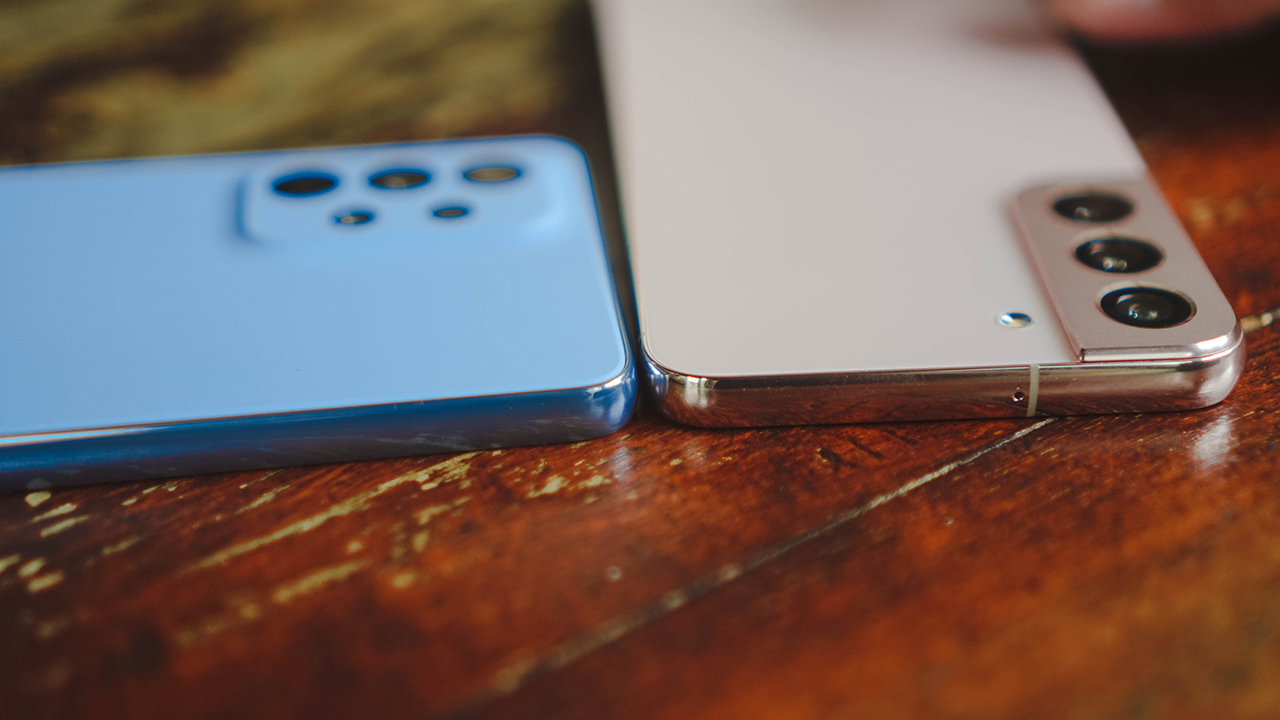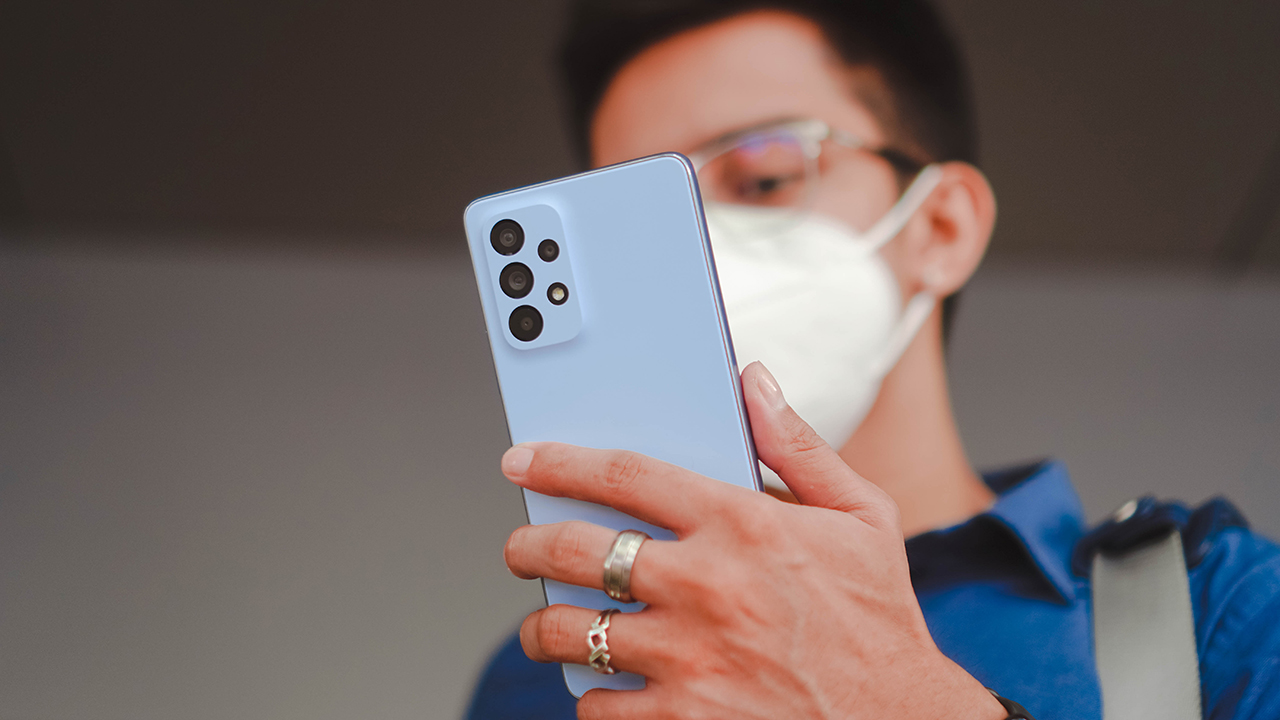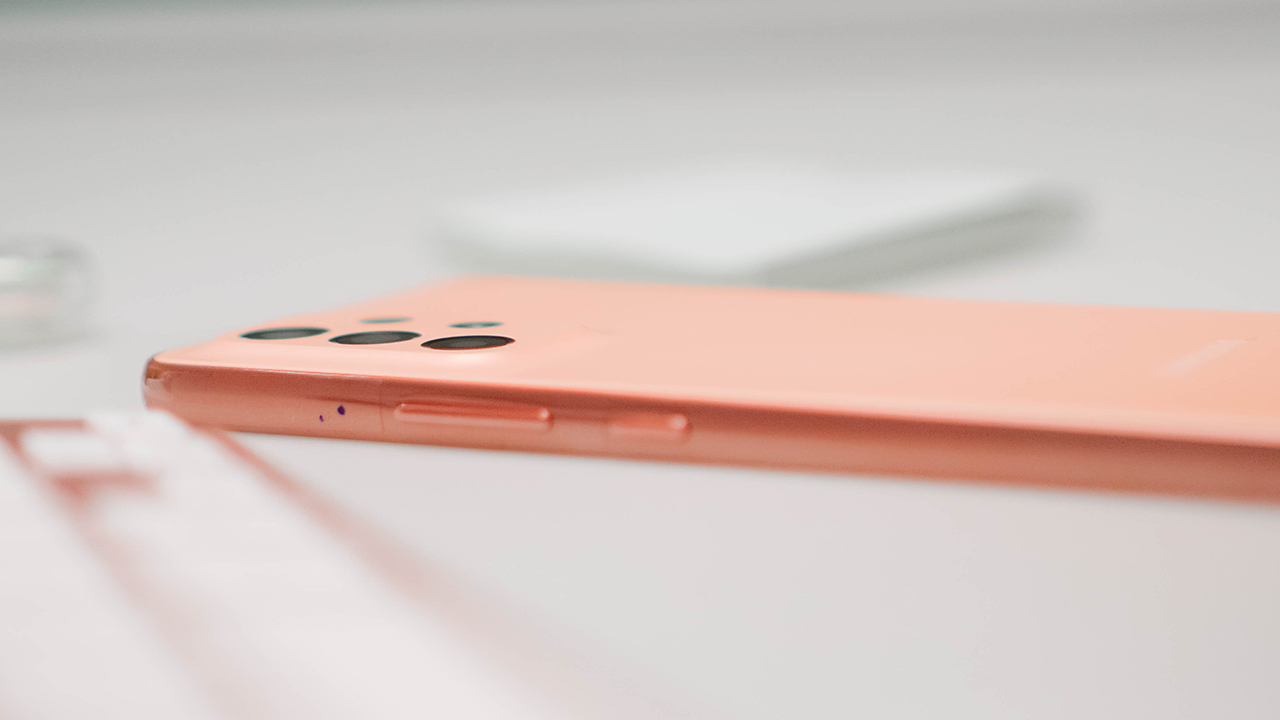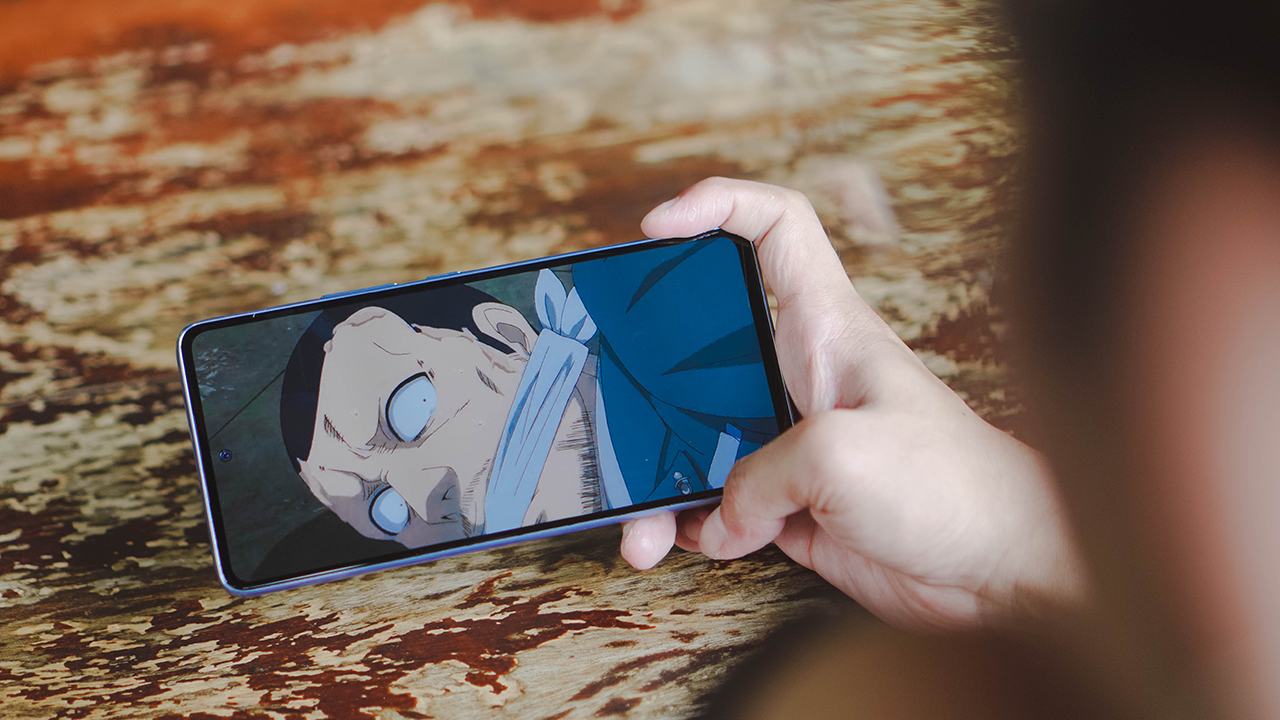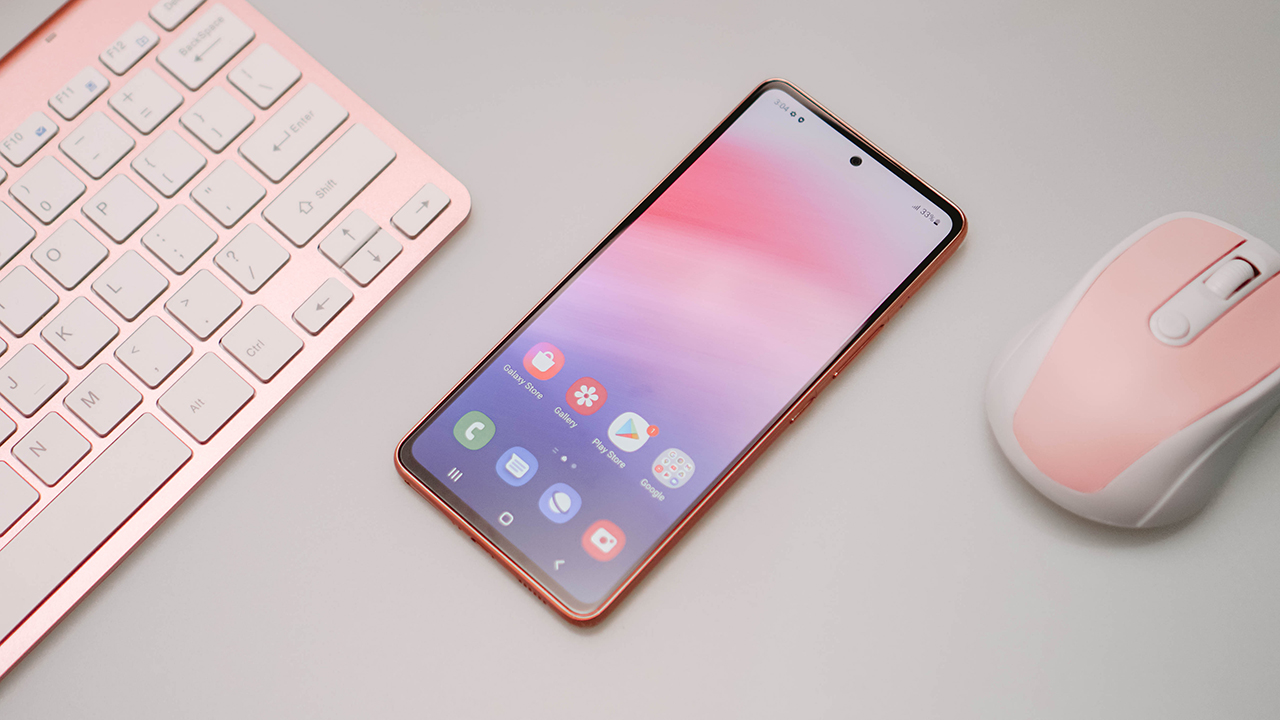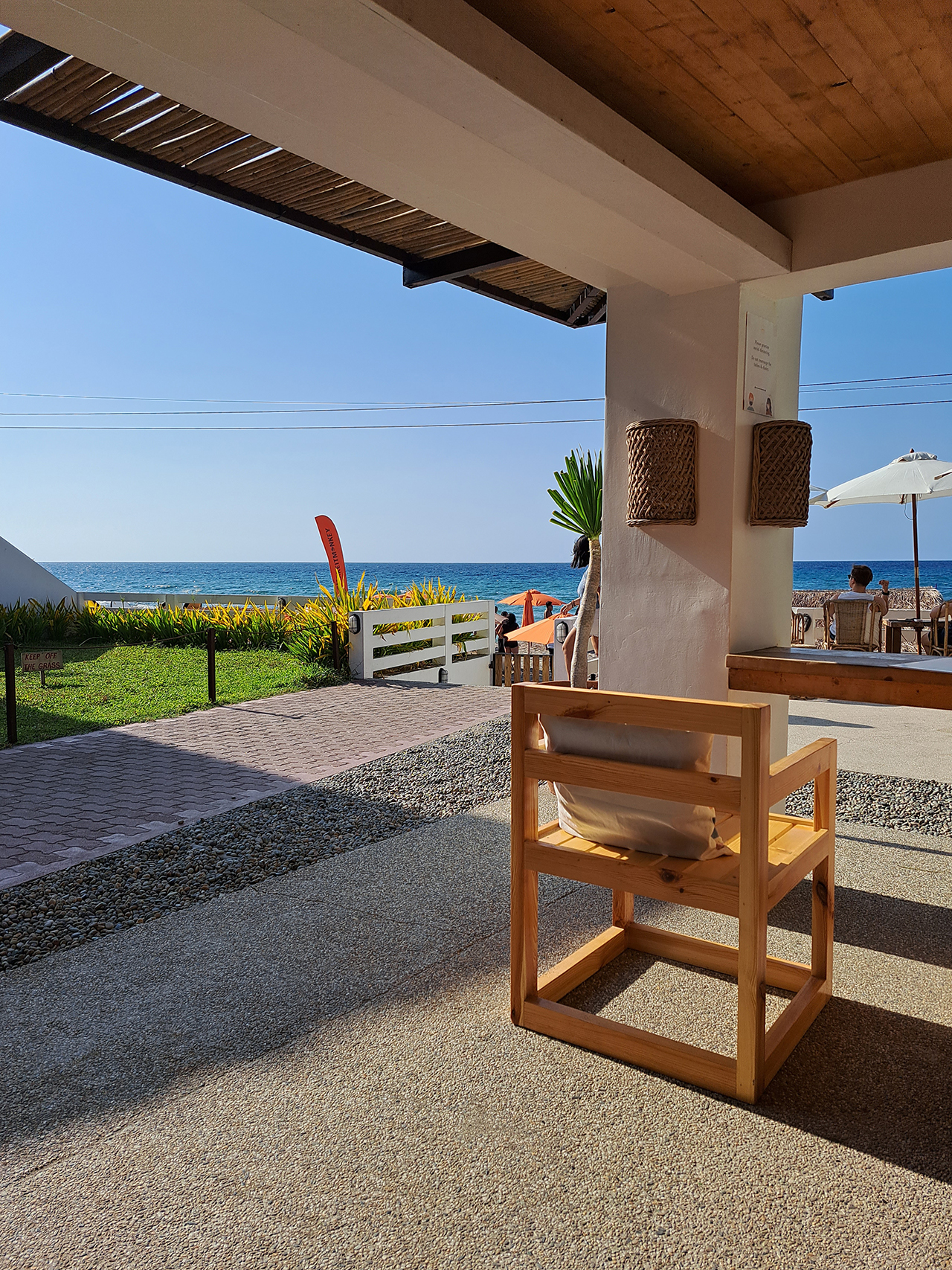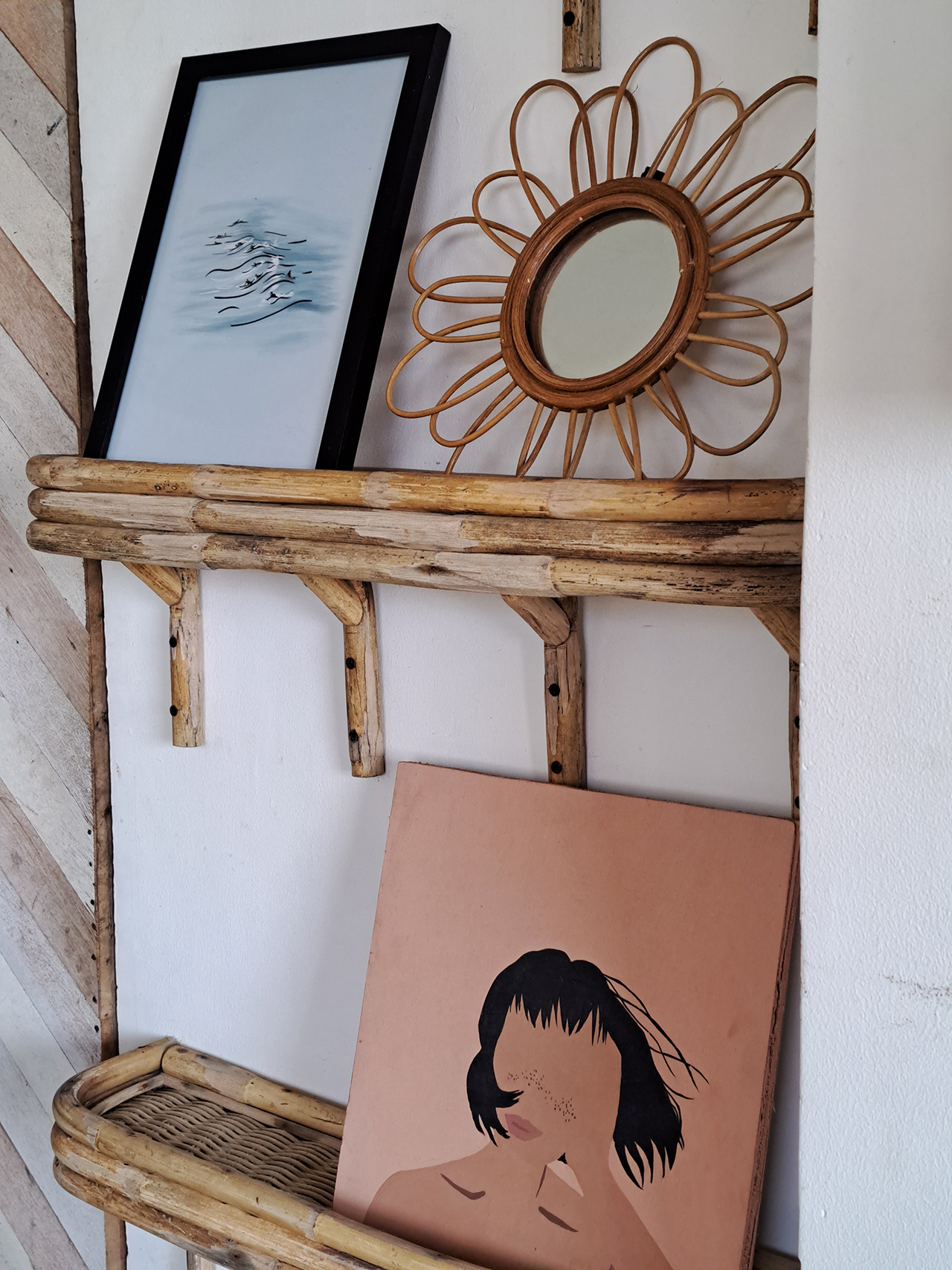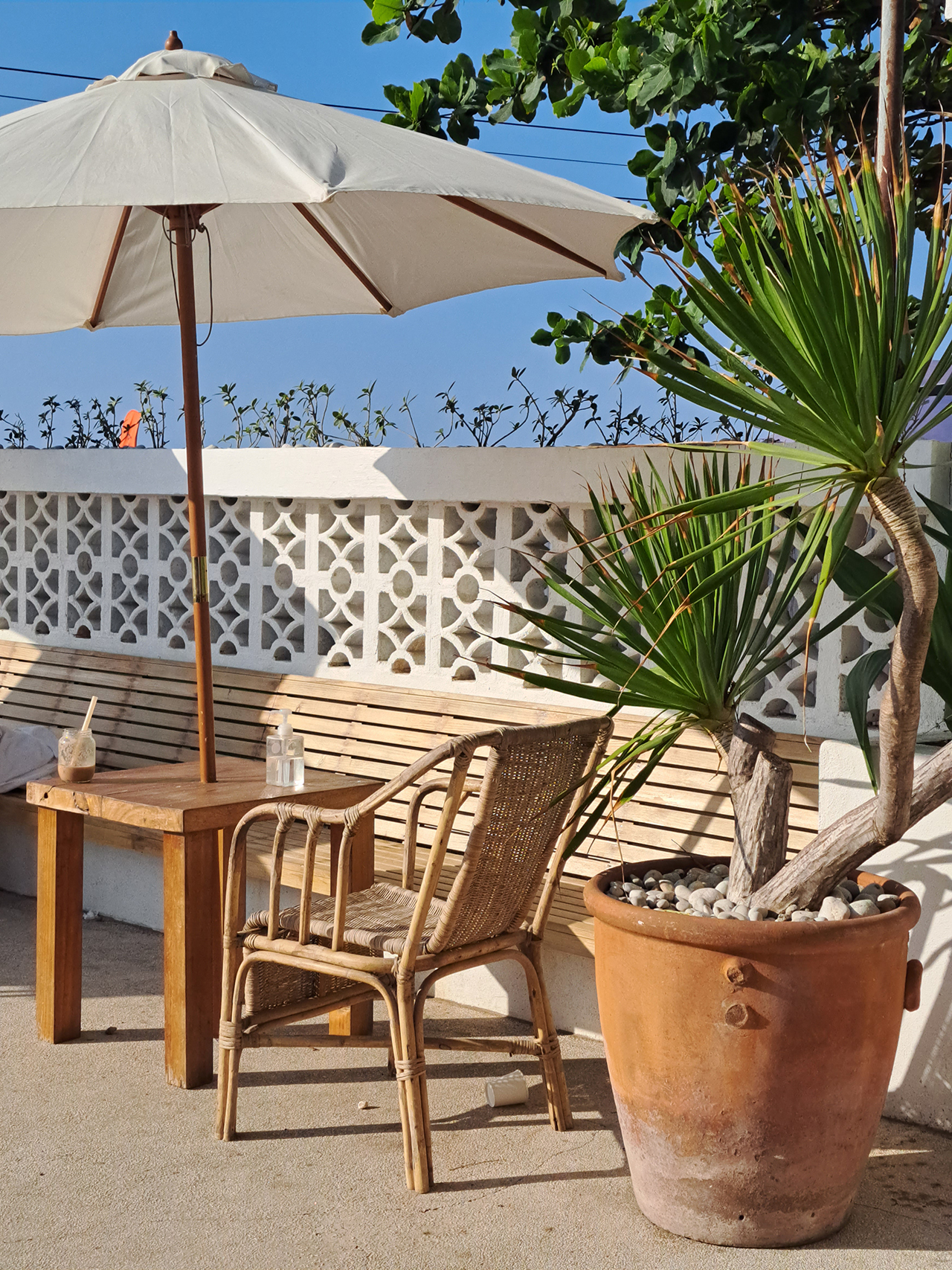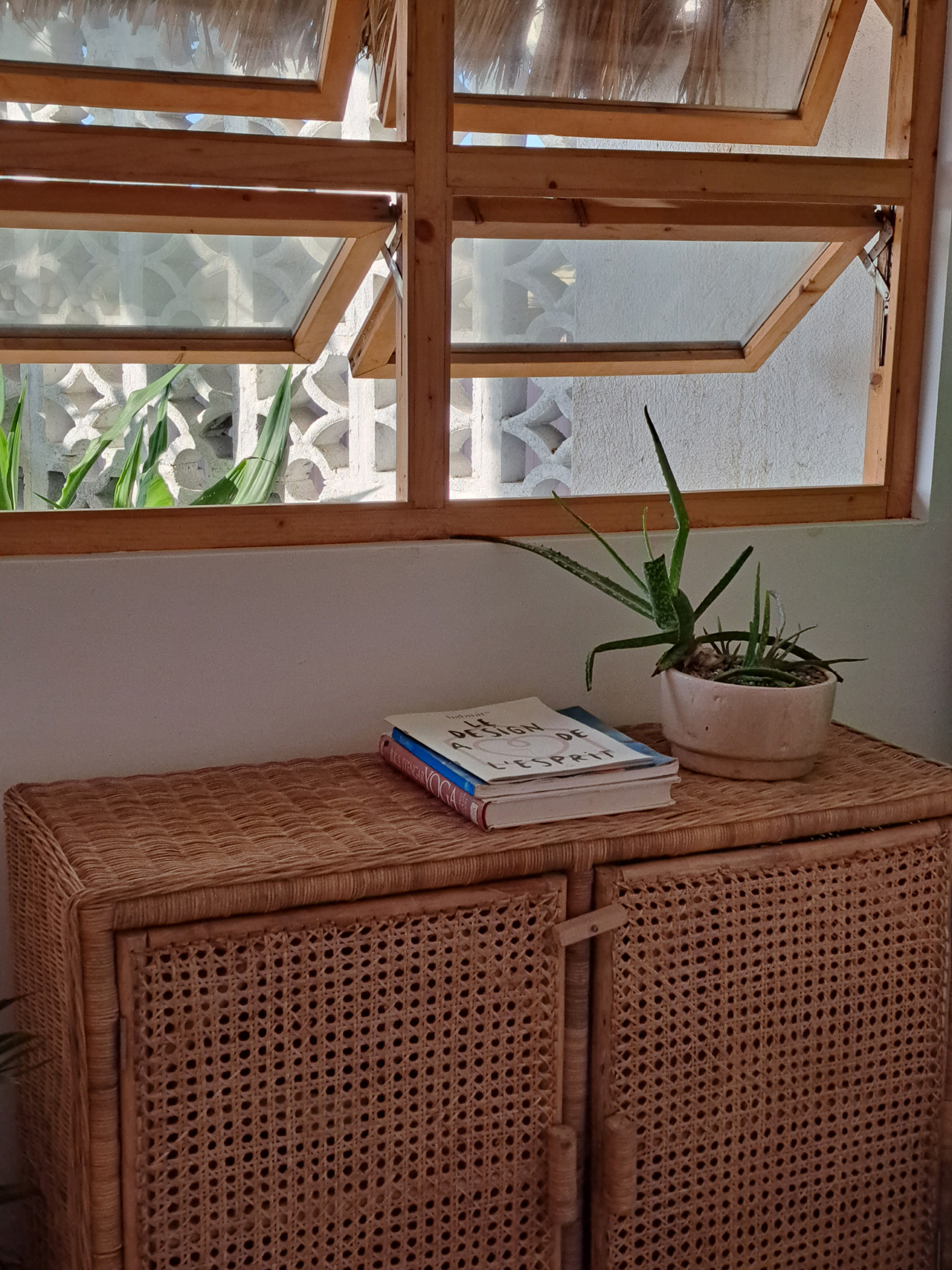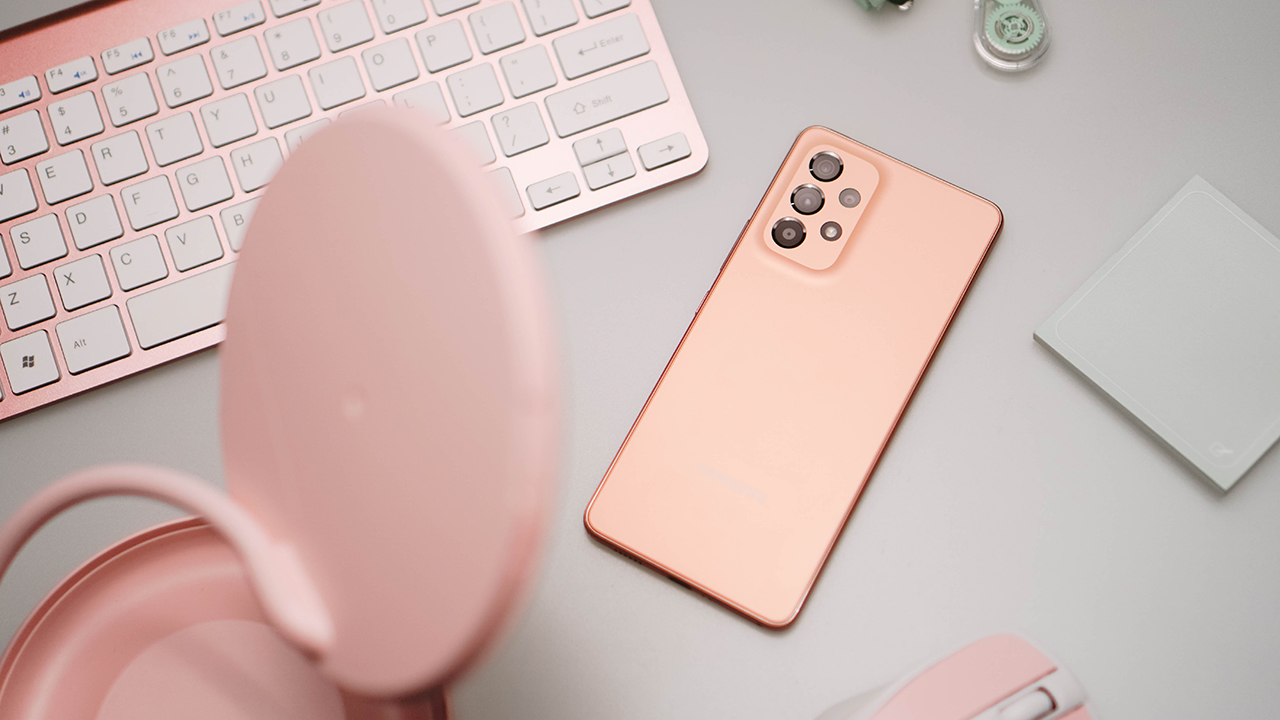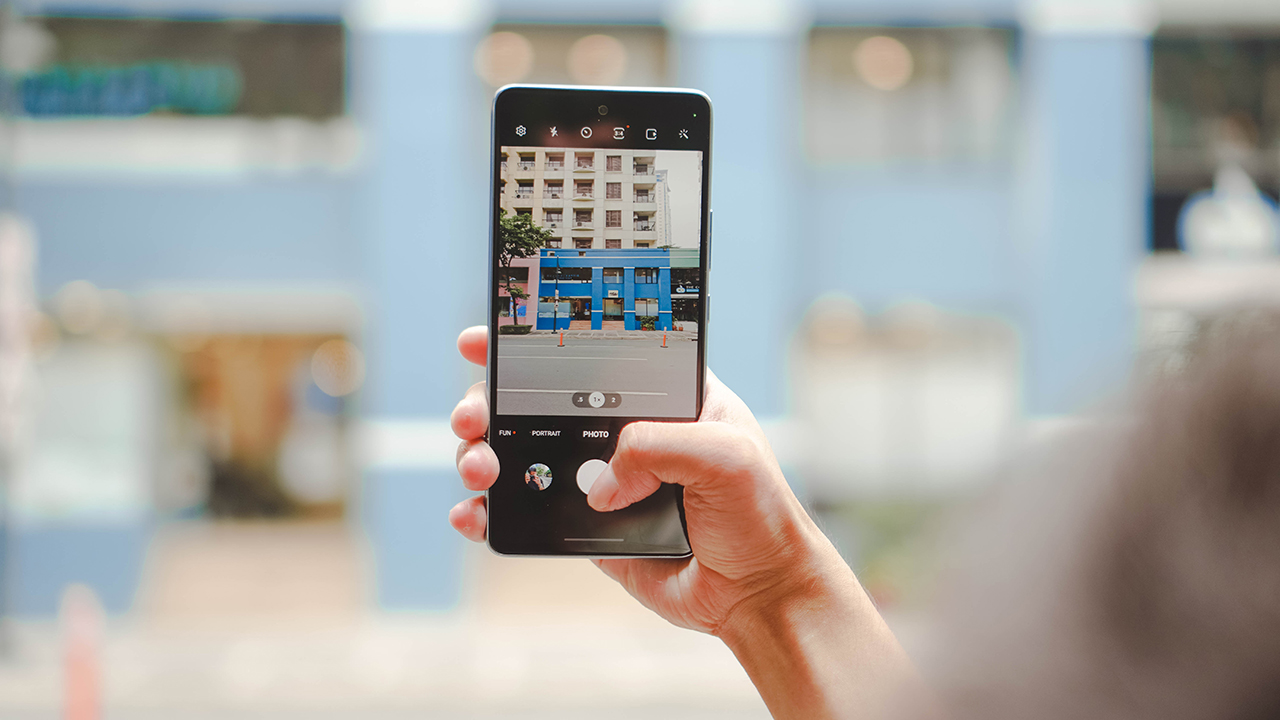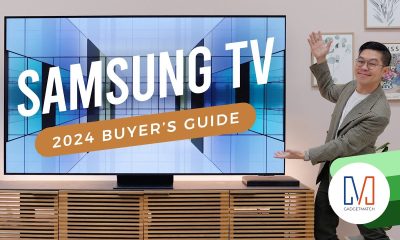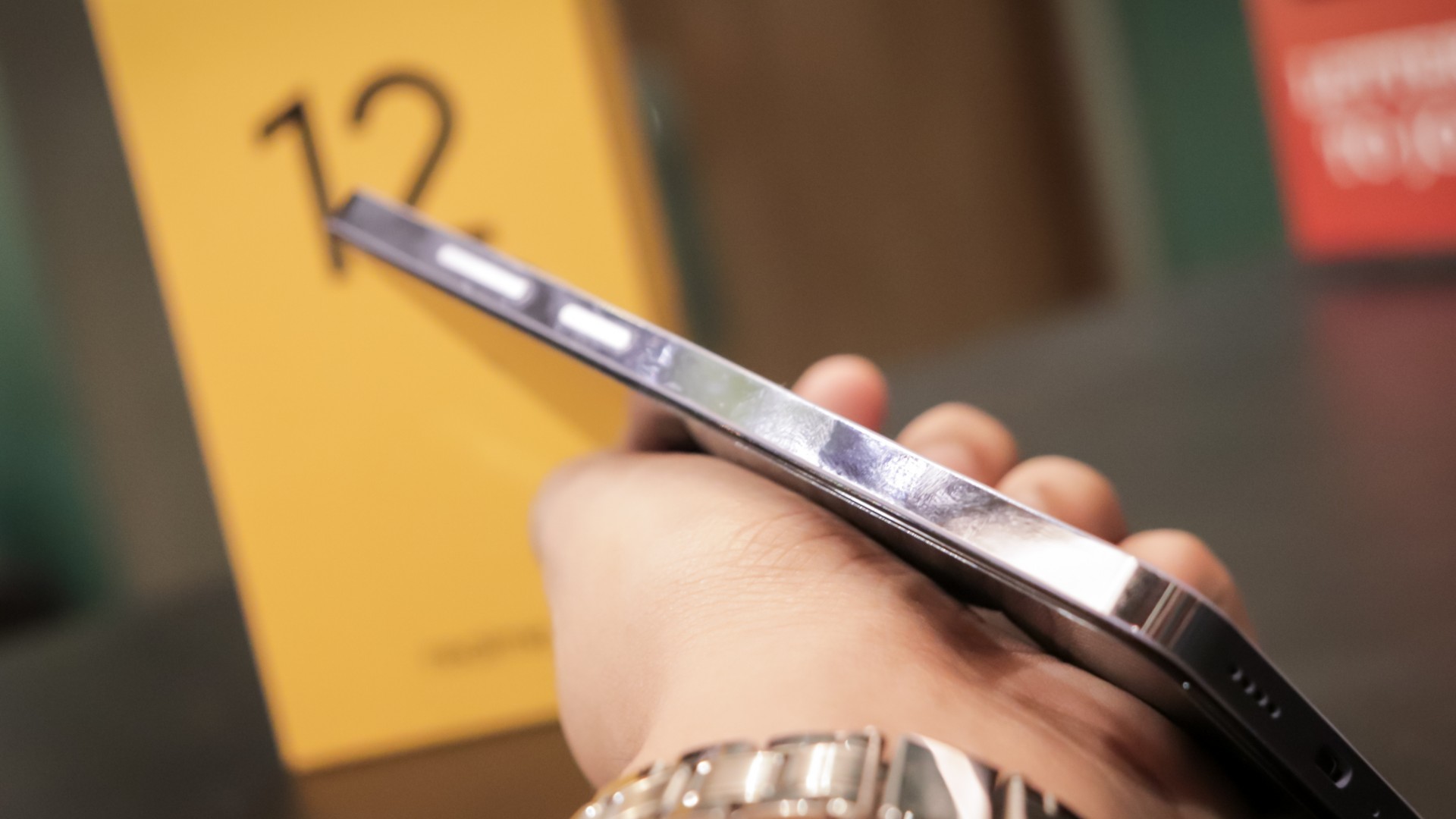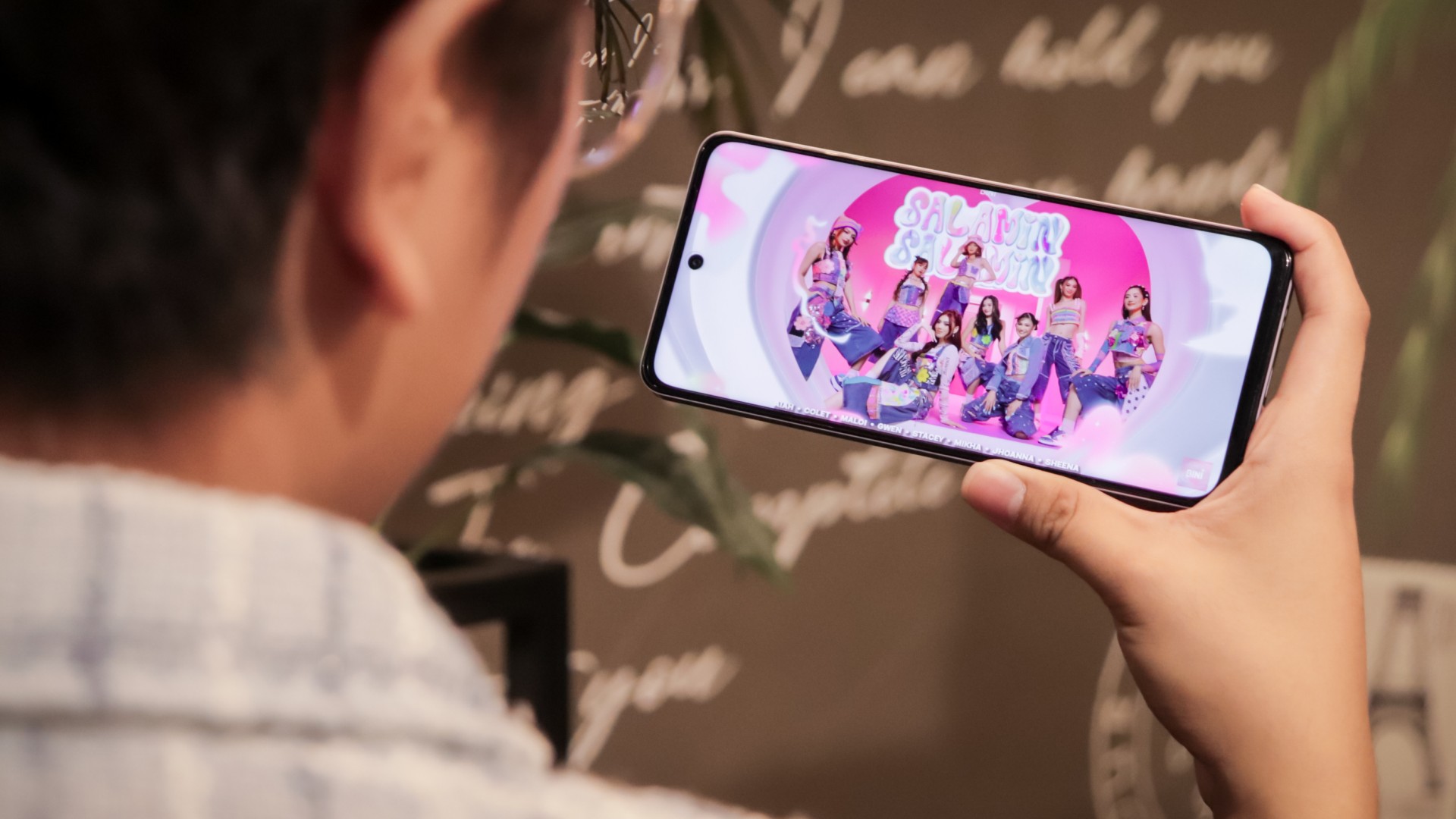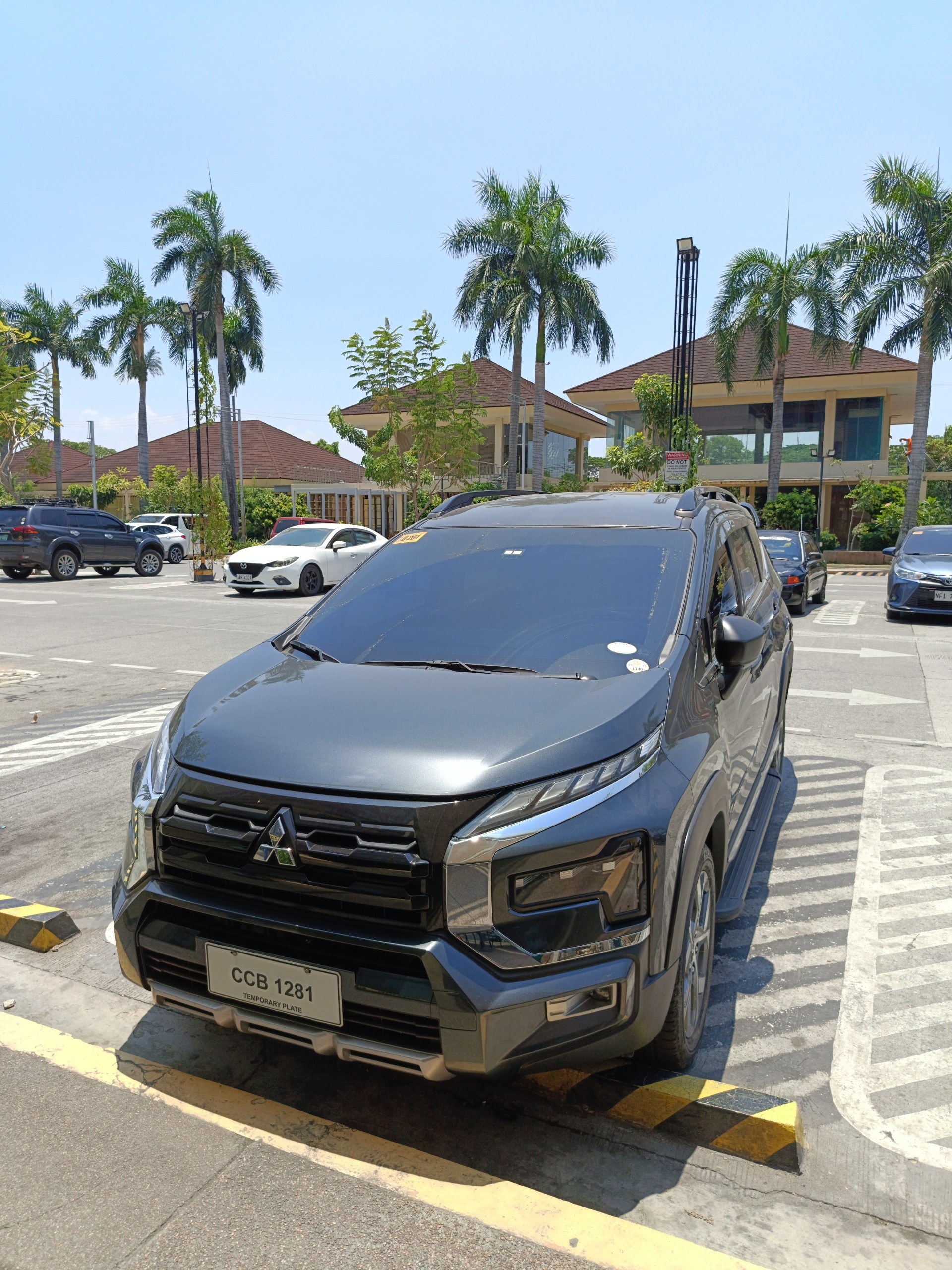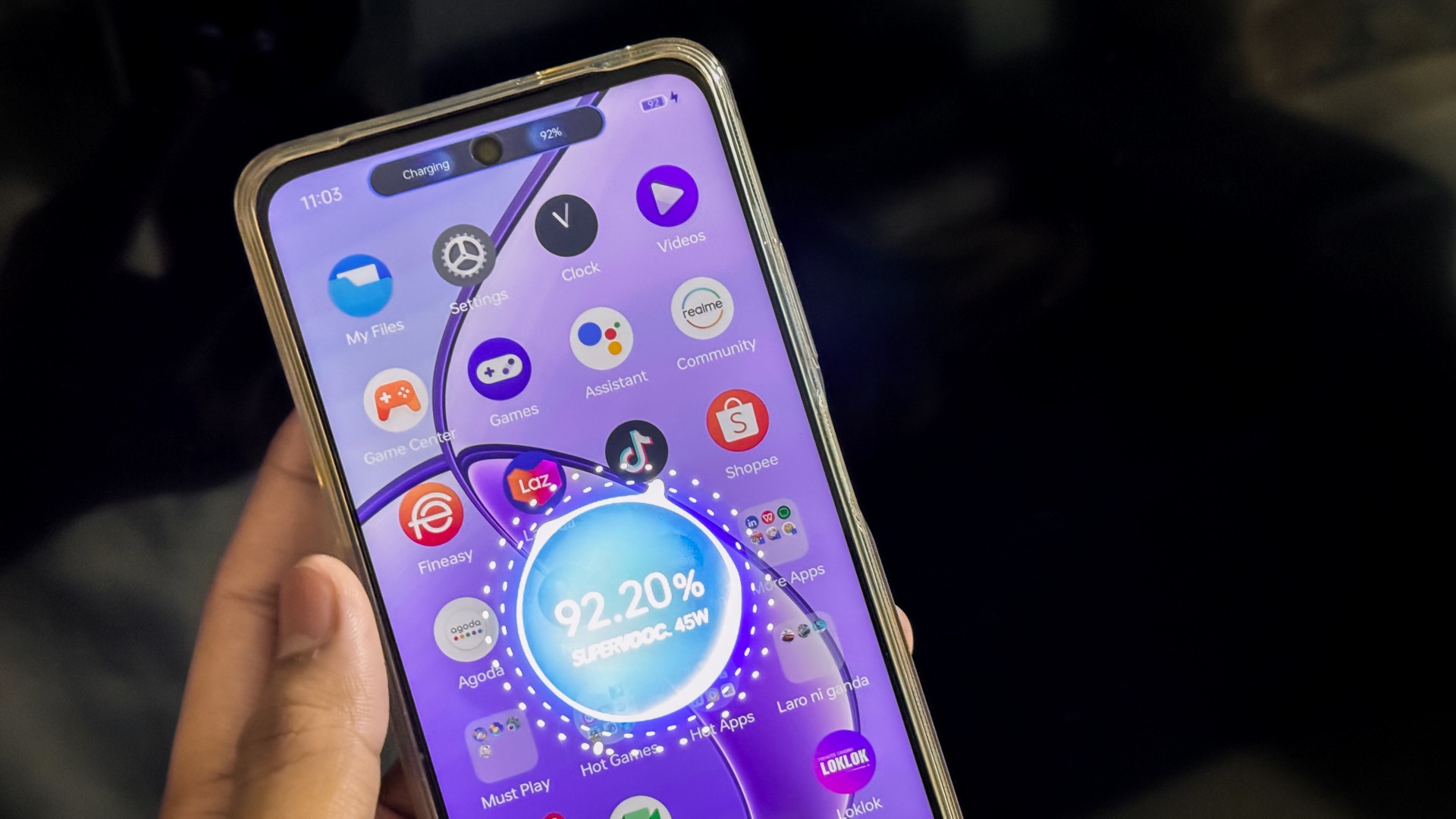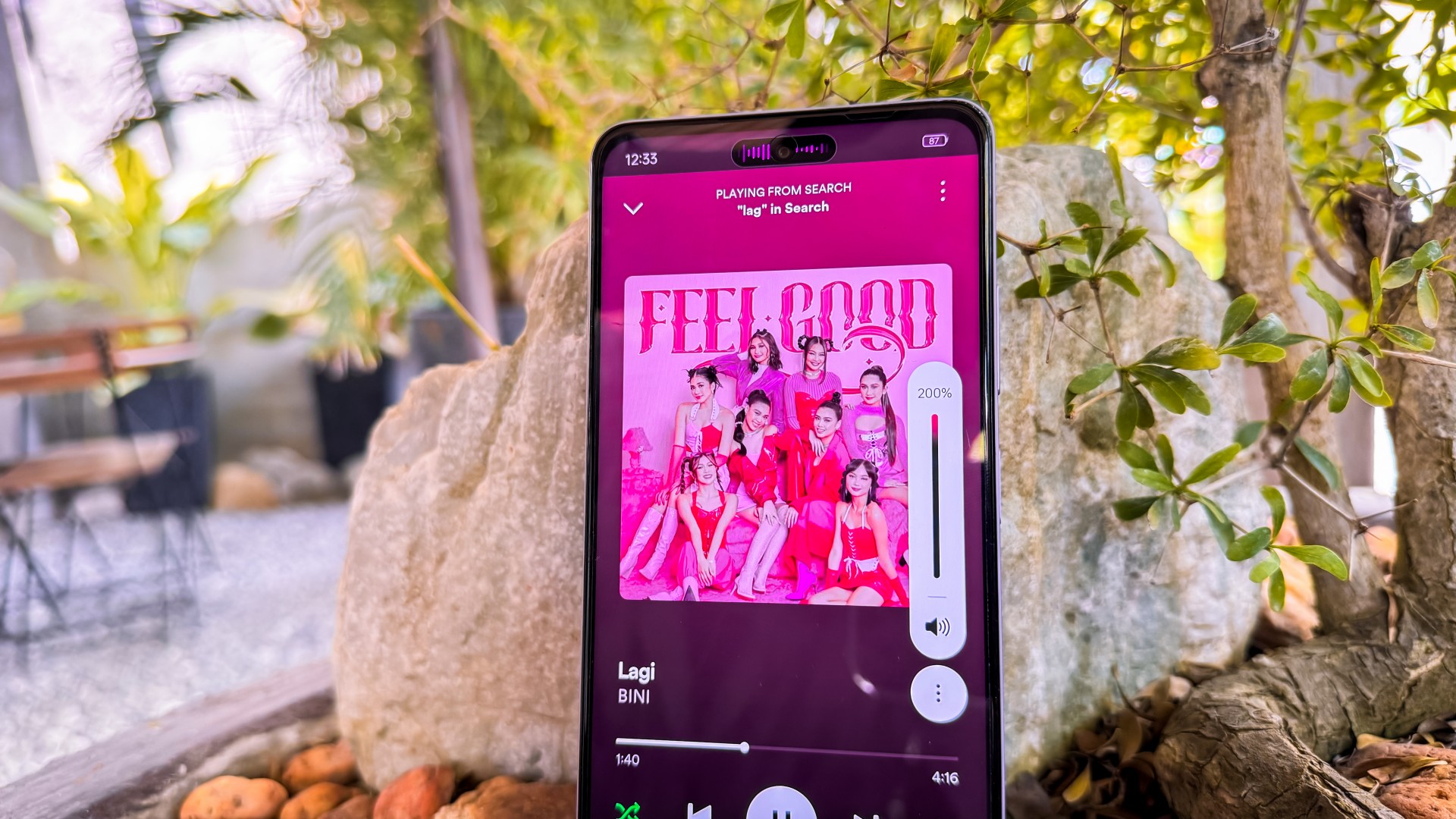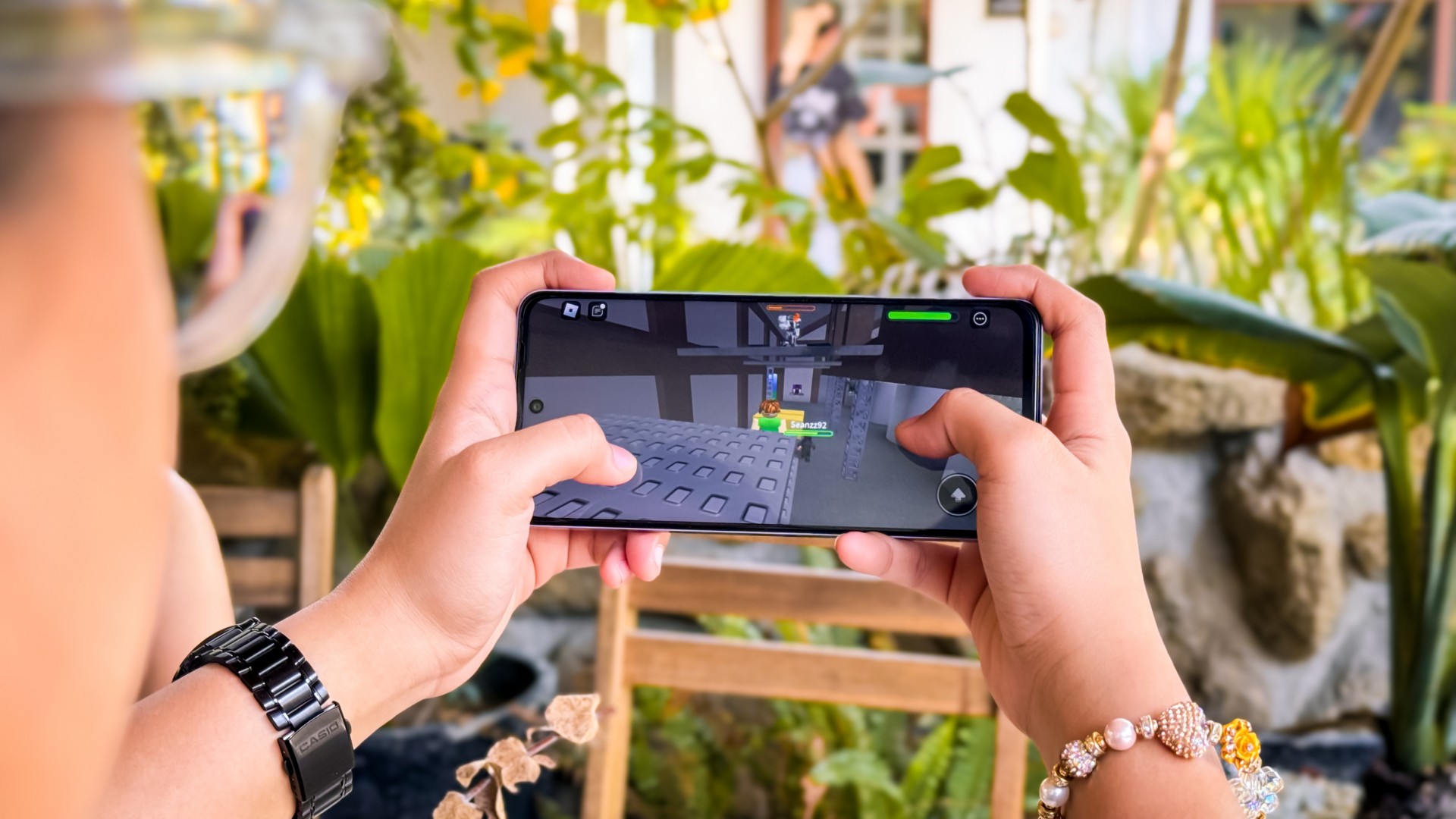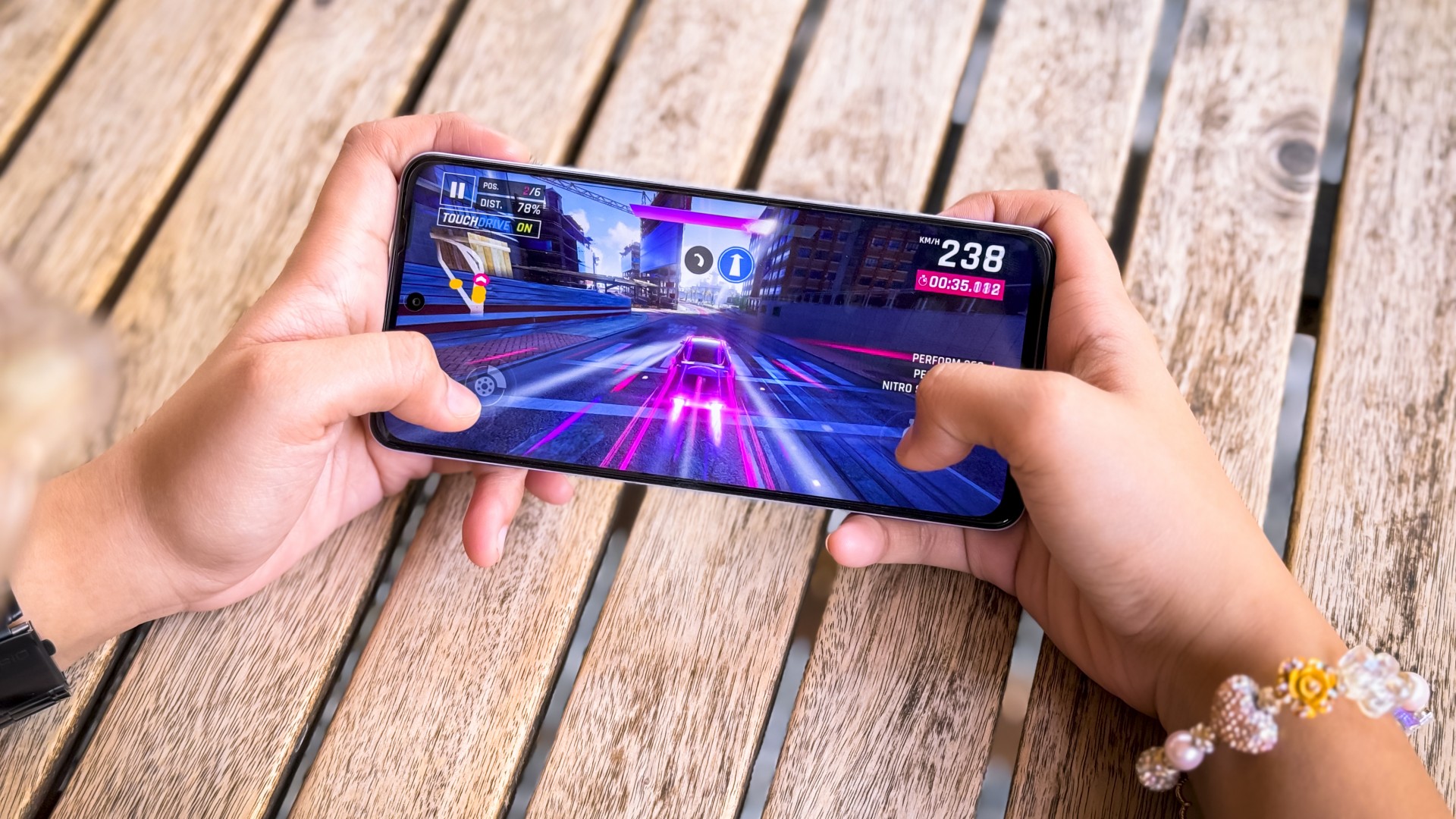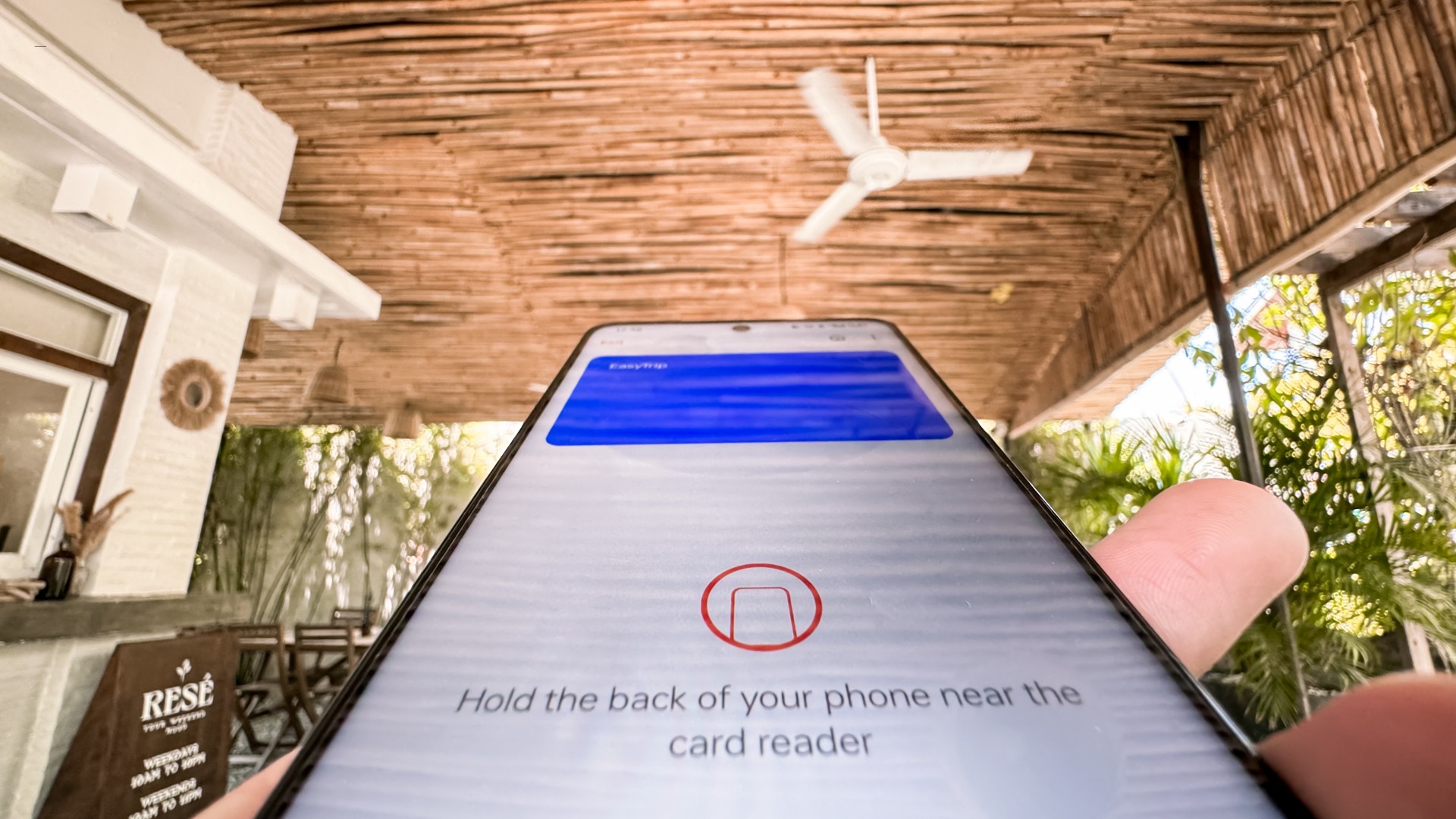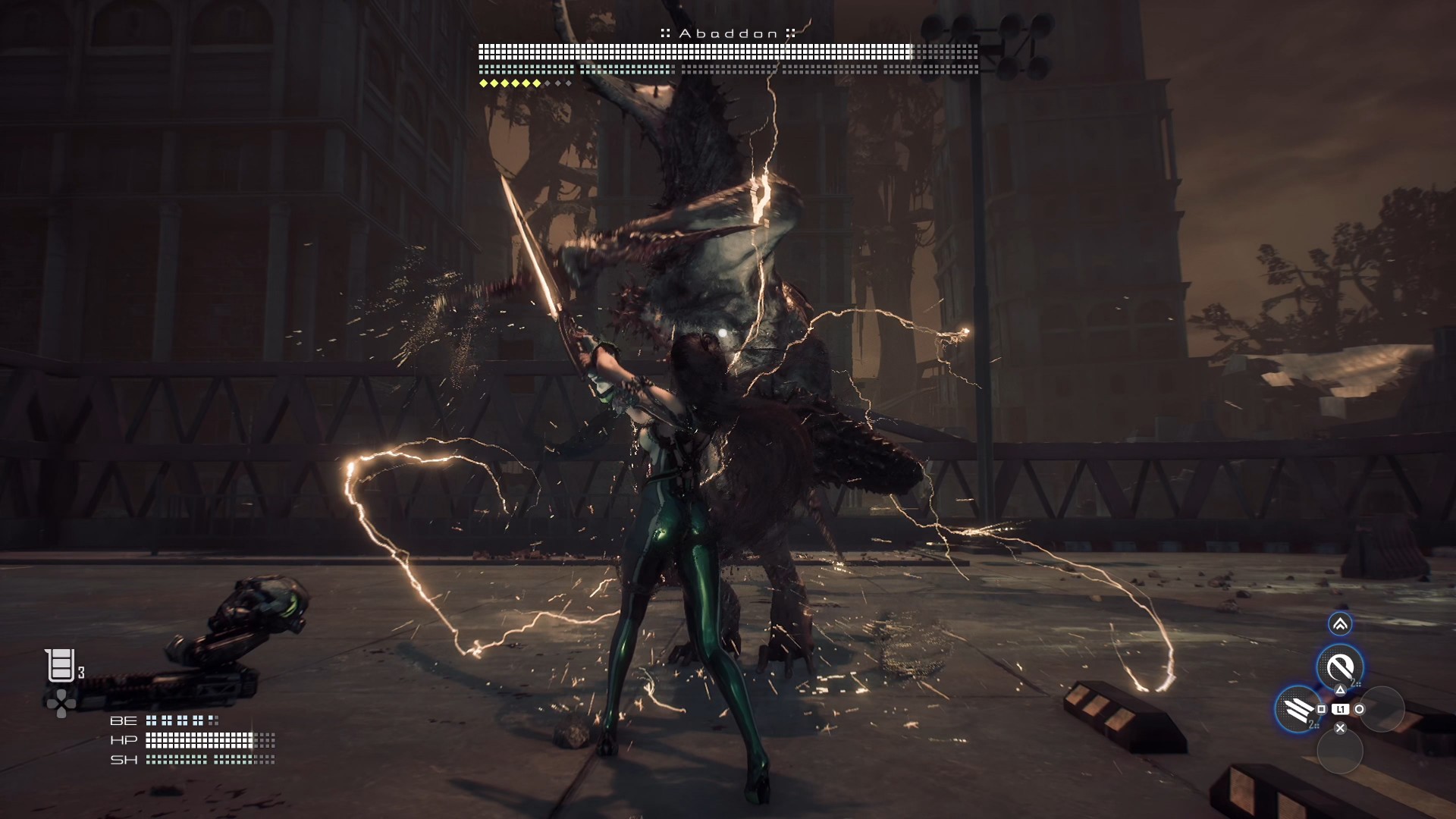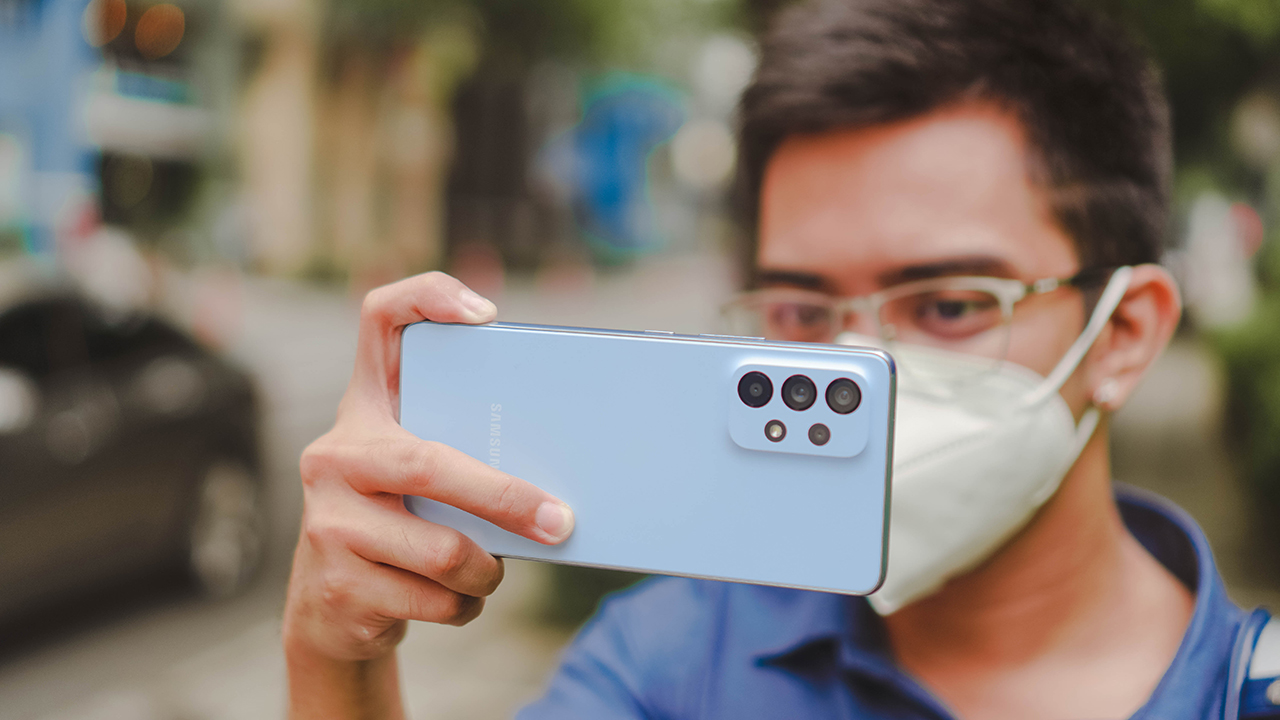

The Samsung Galaxy A53 5G dazzles in the midrange segment, serving as one of the headliners for the new Galaxy A series. Following its predecessors’ footsteps, the Galaxy A53 5G, which we’ll call A53 for brevity, aims to build on its legacy as the sweet spot for most consumers.
In fact, its predecessor from 2020 — the Galaxy A51 — sold the most for Android smartphones during the year’s first quarter. A testament to the Galaxy A series’ dominance in the midrange market. Can this year’s headliner dominate once again? And more importantly, can it be your GadgetMatch? It’s time to find out.
Subtle, gentle design
At a glance, it exhibits the same design language as its siblings in the new Galaxy A series. The lineup took semblance to its predecessor, albeit altering a few iterations that are quite visible if you take a closer look.
The camera island’s edges are gentler and the cameras themselves aren’t protruding nor sunken anymore. It also has a matte finish on its back, which looks quintessential when paired with pastel colors.
Our unit came in Awesome Blue, which I am indifferent about despite having a penchant for anything blue. If it came in White or Peach, I might’ve been ecstatic.

An unpublished, out-of-focus photo of the writer holding the Galaxy A53 5G in Awesome Peach, exquisitely paired with his Rose Gold Macbook Air and Mystic Bronze Galaxy Buds Live taken during the launch of the Galaxy A series in the Philippines.
Nevertheless, the A53 is still a beaut and a sight to behold even if its design is already exhausted. There’s a small change though. Its side frames are made of glossy metal that racks up smudges but offers a gentle yet inconspicuous curve.
This made way to a flat front panel, which we truly adore because we’re over curved screens. (And it doesn’t really make sense when it comes to user experience in the long run.)
As premium as it gets
Looking at its sides, you’ll realize it’s quite reminiscent of the Galaxy S22+. The resemblance is uncanny when you take them side by side. But judging by the colors, you’ll know the Galaxy S22+ is the premium one.
Of course, some would say the A53 is as premium as its gets. It probably is for the price it commands. However, the best indicator for a phone to be called premium is the experience when you hold and use it.
Which, for me, the A53 doesn’t quite to deliver. In spite of that, I like how the A53 felt secure in my hands. It’s comfortable to hold and use, it felt sturdy and it fits snugly. You can actually use it with one hand since the weight is evenly distributed.
It may not have an elegant air in the way you experience the phone, but it surely can promise a daily driver you’ll be comfortable using day in and out.
Frankly, not even my photos can do justice to the beauty that the A53 exudes. If you have a chance to check its vibe on any Samsung Experience store, only then will you understand how magnificent its look and feel are.
Got me walkin’ side-to-side
Of course, there are some questions that need to be answered. Here are some closeups of the Galaxy A53 5G, but in an Awesome Peach colorway.
On the right side of the frame, you can find the volume rocker and power button. Meanwhile, the left side is empty and the top side houses a tiny hole for the microphone.
The bottom part houses the SIM tray which allocates a dedicated slot for your primary SIM card, while the second hybrid slot gives you a choice between using a secondary SIM card or a microSD card.
You can also find the earpiece which works in tandem with the bottom-firing speaker for a stereo setup, and a USB-C port that can handle USB 2.0 data transfers. There is no 3.5mm audio jack, so it’s time to use USB-C wired earphones or just switch to the wireless side.
For privacy, the A53 uses an under-display optical fingerprint reader, which is quite swift and reliable.
Ideal for binge-watching
The Galaxy A53 5G continues the display that was passed on from the Galaxy A52s 5G and the Galaxy A52. It comes with a 6.5-inch FHD+ Super AMOLED Infinity-O display, which we quite enjoyed using for entertainment.
As a midrange smartphone, the display surely isn’t top-of-the-line but it still gave a reasonable audio-visual experience. In fact, I was able to watch Spy x Family on Netflix while sipping my favorite Maple Vanilla Cold Brew outdoors. Even with glaring sunlight around three in the afternoon.
I wasn’t afraid to drink my cold beverage, which quickly condenses due to the scorching heat from dining outdoors leaving water drops and getting the table wet. I worry a lot because I tend to forget that some phones don’t have IP67 certification that can handle water and dust resistance. Luckily, the A53 has one.
Furthermore, its screen is protected by Gorilla Glass 5, so rest assured that your screen can get away unscathed on sudden falls (as long as you don’t drop it high and with impact). It’s not scratchproof, though.
Nearly smooth performance
If you play games casually or competitively, the A53 allows you to choose between a 60Hz (Normal) or 120Hz (High) refresh rate. My unit runs on an Exynos 1280 processor, 6GB of RAM, and 128GB of internal storage, yet I was still able to play Call of Duty Mobile smoothly.
There weren’t any sudden lags and/or delays during the gameplay, although the phone heats up gradually when you keep playing even if you are indoors chilling in a frosty, airconditioned room.
The only time I experienced delays was when I connected the A53 to the Samsung The Premiere, a premium ultra-short-throw projector (it costs a fortune) that can be controlled using Samsung’s SmartThings along with many Samsung devices.
I was able to tap in and mirror my phone wirelessly to watch the different kinds of content I enjoy consuming. Should I insert a winky face here? Regardless, the experience with Samsung’s ecosystem drew the line between a midrange and a flagship smartphone.
I don’t think taking an A53 with the highest configuration can improve the wireless mirroring mishap. However, I do believe that it’s enough to revel in the seamless connectivity that Samsung offers through its products. After all, the A53 responded well to my Galaxy Watch4 Classic, my Galaxy Buds2, and even as a remote control for Samsung TV.
One UI goodness
The Galaxy A53 5G runs on One UI 4.1. Apologies for the previous infographics we shared during the launch. Initial information showed Samsung slapped a One UI Core for its midrange headliners.
I was afraid to use a One UI Core phone for security purposes. With One UI 4.1, I get to enjoy the same user experience I had with Samsung along with the features and security I enjoyed previously.
There’s the Secure Folder where I keep all my intimate photographs and important notes, and the updated Knox security gives me peace of mind, too. If you’re unsure how it works, here are two stories for you to munch on: “Why the White House prefers Samsung” and “How Samsung Knox protects your smartphone.”
Further, the One UI 4.1 is based on Android 12 and it’s the same skin as the ones used in the Galaxy S22 series. There’s also an additional feature called RAM Plus that lets you virtually expand the RAM you want.
Documenting your trips and everyday life
Onto cameras, the A53 is equipped with a quad-camera system on its rear: a 64-megapixel main sensor, a 12-megapixel ultrawide sensor, a 5-megapixel depth sensor, and an additional 5-megapixel shooter. Upfront, it comes with a 32-megapixel selfie shooter housed in a punch-hole.
It’s time to peruse these photos!
Wider and closer
Due to the focal length, the A53 takes sharp, dim photos indoors when you use the ultrawide angle mode. It gets brighter when you use the 1X and the 2X optical zoom.
The same scenario is evident when capturing the hallways of this church. Although, the regular shot has a hazy appeal which I often encounter when Samsung’s cameras are struggling between brightening a dim space on a scorching hot day.
Outdoors, the Namacpacan church looks vibrant when taken with the ultrawide angle mode. It still has that softened, hazy effect when using the 1x and 5x optical zoom.
Summer ready
On another note, the A53 takes vibrant yet nearly-natural photos during the daytime. The post-processing isn’t as aggressive as we’d think, so padding a built-in filter would give you social media-ready photos.
Instagrammable shots
Okay, we’re guilty: We’re fond of using the optical zoom to achieve that perfectly cropped ‘Instagrammable’ magazine-aesthetic shot. It’s nice to know that the A53’s optical zoom retains details and still produces an output with balanced colors.
Softer cutouts
What I would probably love about the A53 is its ability to take focused shots even when you use the regular Photo mode. It’s reminiscent of captures from flagship smartphones such as the Galaxy S, Fold, Flip, and even the older Note series. Just look at those creamy blurs, it’s not even from Portrait Mode! That feature really sucks.
The inconsistencies
Samsung has been consistent in producing inconsistent shots when it comes to color balance and temperature. Look at the burger and the sunflower, colors are either washed out or have a warmer and greener undertone. The color accuracy is just inconsistent.
Adequate selfies
I didn’t take plenty of selfies this time around, most likely because it never changes. I could probably insert a selfie from the Galaxy A51 or A52, and you’ll barely notice the difference except for the lighting on the face’s contour.
There are visible grains whether you take your selfies indoors or outdoors, but unnoticeable when you upload them on social media because of the compression.
Sunset vibes
I like how the A53 has a good grasp of backlit and sunset shots. The brighter, backlit shot was taken at 5 in the afternoon while the sunset shot was taken around six o’clock when the sun was setting. The color is accurate, and I’m happy that it didn’t pad any additional processing so I can have the freedom to apply a preset that aligns with my aesthetic.
Lowlight
The A53 struggles in taking photos in lowlight or dim spaces.
Night
It’s worse when taking photos at night, even if you use night mode. In a nutshell, the A53 is a good companion for your everyday life during the day but at night, you’re better off putting it down or keeping it inside your purse. It’s disappointing, but in reality, it’s one of the compromises and challenges that midrange smartphones offer.
Battery
I have used the Galaxy A53 5G as a daily driver, as a mobile hotspot, and as a binge-watching companion. Safe to say, that sizable 5,000mAh battery can last you through your full, eight-hour shift at work.
It’s better at being on standby, but not as good when compared to other midrange smartphones at the same price point.
The A53 handles 25W fast charging, although, it’s far from being fast. Using the old 25W Samsung Charger I have, I started charging at 1 percent. An hour later, the A53 had a 59% battery.
It reached a hundred percent later on after an additional 41 minutes. It really takes a while before you fully charge it. I hope Samsung can move past this slow ‘fast’ charging, I actually need my phone back asap when I charge it.
Price and availability
The Samsung Galaxy A53 5G comes in different price points depending on the configurations: PhP 22,990 for 6GB/128GB; PhP 23,490 for 8GB/128GB, and PhP 25,490 for 8GB/256GB. It comes in Awesome Black, Awesome White, Awesome Blue, and Awesome Peach.
The price it commands is quite steep, especially when you compare it to its predecessors. The range is competitive since most players in the market release their worthy midrange headliners with similar price tags.
Is this your GadgetMatch?
I could get away with using the Galaxy A53 5G as a daily driver if I’m out and about. Somewhat a secondary phone that can act as a mobile hotspot, especially in a city where crime is still prevalent. But for most people, that isn’t a privilege they can have.
So, let’s ask you these questions instead: Do you like binge-watching shows and streaming music on a daily basis? And do you like capturing your memories for the sake of preserving them?
Perhaps, sharing them on your social media accounts? If you answered yes to these two questions, then you found your GadgetMatch.
The Samsung Galaxy A53 5G is quite a sturdy, reliable everyday phone that supports you in your daily activities. It’s got a battery that will go on with you as you get through your day; cameras that are clear and detailed to capture every moment passing by during the day; and an audio-visual treat that entertains you whether indoors or outdoors.
While there are still dealbreakers that should be considered depending on your preference, the Galaxy A53 5G truly dazzles in the midrange segment.
What could be your alternatives?
If you’re in need of a performance-oriented smartphone or a device that focuses on certain features, ’tis isn’t going to be the one. Maybe the Galaxy A73 5G can satisfy your camera needs.
Perhaps the Xiaomi 11T Pro, if you want better performance in all aspects? Or maybe, get the Xiaomi 11T if you want another all-arounder that leans towards a near-flagship experience.
Nevertheless, the midrange segment is crowded with well-rounded devices perfectly suited as everyday phones. It’s going to boil down to what brand you like to be associated with, and the ecosystem of the devices you use. In my case, I’ll probably go with Samsung or Xiaomi — you can never go wrong with these two.

Reviews
realme 12 5G review: It was enchanting to meet you
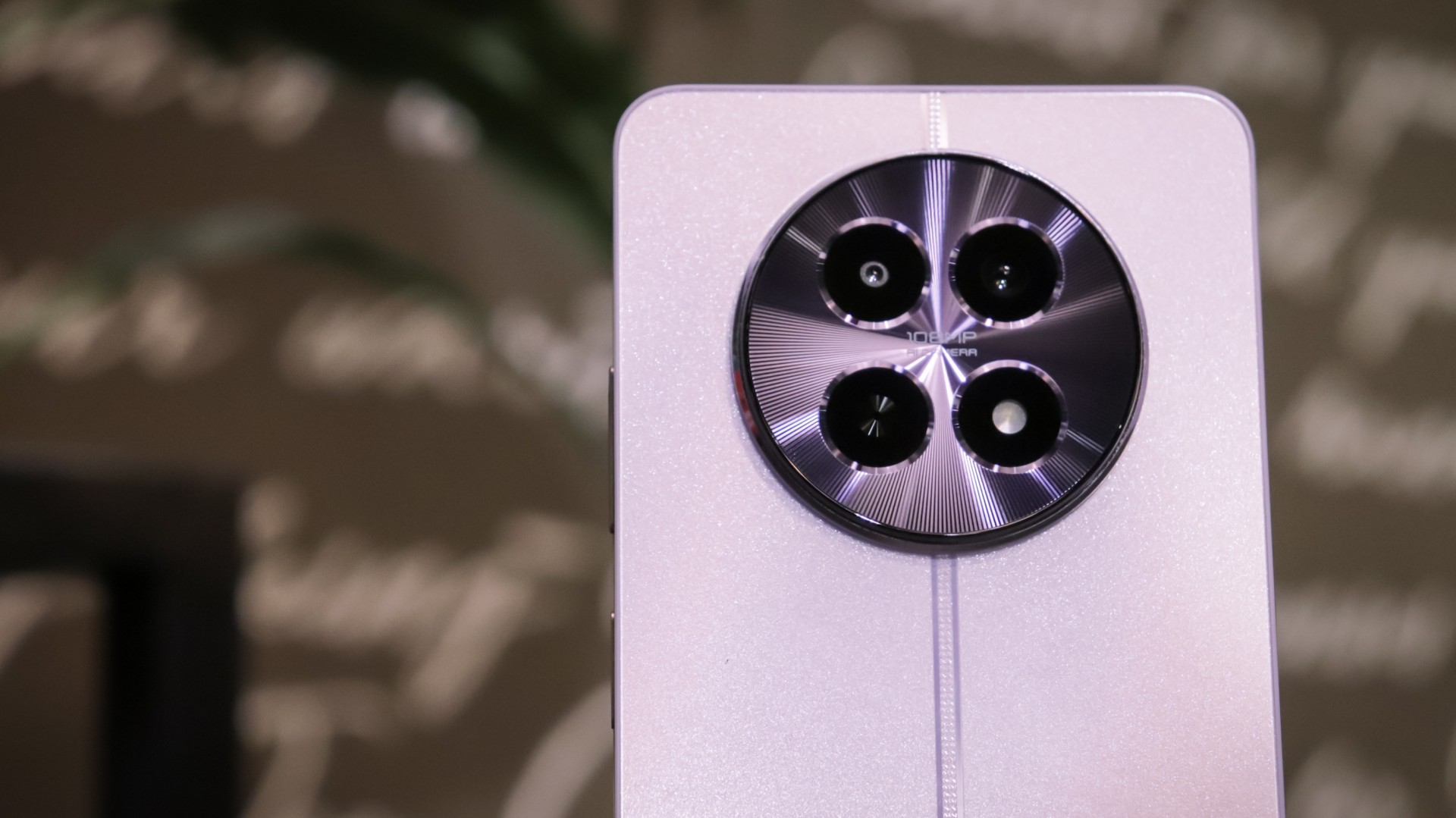
Just when we thought the Midnights’ era was over and the clock’s hands are now pointing to the tortured poets, a ‘Lavender Haze’ has arrived in the midrange smartphone department of the Philippines.
The realme 12 5G is here, and dang, does it look magical!
Just over a month after the official release of the realme 12 series, a new younger sibling just arrived, dead set on satisfying a niche that wants a competitive mobile device but has arguably smaller pockets.
You showed me colors you know I can’t see in anyone else
Right off the bat, the realme 12 5G is nothing short of stunning. The unit I have is in Twilight Purple, and believe me when I say that it’s a feast for the eyes. The other color variant of the phone is Woodland Green and its deep green hues will certainly win many hearts as well.
Despite not having the vegan leather of its older siblings, the realme 12 5G still has the ability to turn heads and serve the borahae aesthetic which a lot of people (count me in!) like.
The camera layout of the realme 12 5G is a visual language we’re familiar with all too well. The luxury watch design is something I will always be a fan of. I really admire smartphone brands that create their own visual identity rather than those who take the easy route of copying a certain bitten fruit brand.
However, I must say that the metal frame of the realme 12 5G is a certified fingerprint magnet. But if you’re like part of the, say, 99% of the population who use smartphone cases, the free clear case that comes straight out of the box is an easy fix. That’s another episode of android-smartphones’-generosity-saves-the-day!
It is also an important thing to note that while I really love the big camera design of the realme 12 5G, it can be bothersome when using the phone in landscape orientation. My fingers are naturally covering/touching the cameras. While it’s not that uncomfortable, you might have to wipe the lenses much more than you think you should.
The ports and buttons are pretty generic for the most part. The volume controls and power buttons are sitting on the right, the USB-C port, stereo speakers, and the 3.5mm headphone jack (yes, a headphone jack in 2024? I know, right!) are on the bottom. realme, however, stepped up the game through the power button because it does not only double as a fingerprint scanner, it also allows custom shortcuts by double-tapping or double-pressing. This feature is called the dynamic button.
A display made for ‘Islang Pantropiko’ (Tropical Island)
Rocking a 6.72 FHD+ LTPS LCD display that supports a screen refresh rate of up to 120Hz is another impressive feature the realme 12 5G boasts under its purple sleeves. With a screen-to-body ratio of 91.4% and a camera punch hole that effortlessly blends with the display, an immersive experience is guaranteed.
The image looks sharp, the colors are vivid, and scrolling on this device is a breeze. Although, I would have loved it more if the bezels are thinner or at least, proportionally distributed but again, that’s just me being a true-blooded Virgo.
But that’s not where the display admiration ends. The realme 12 5G also supports up to 800 nits of screen brightness. It can go further to 950 nits when the ‘Extra Brightness’ mode found on the display settings is toggled on.
This makes the display easily viewable even outdoors. That’s especially true during these ‘Islang Pantropiko’ summer weather when the sun’s scorching heat is not that forgiving to smartphones with dim displays.
The cameras: Do I love it? Do I hate it? I guess it’s up and down!
I would like to be very honest, I initially wanted to name this portion of the review as “The tortured camera department” but I feel like that would not be accurate of what I really feel towards the shooters of the realme 12 5G.
The smartphone sports three cameras in total. At the back lies the 108MP main camera that supports 3X zoom and a 2MP portrait camera. Meanwhile, the 8MP AI selfie camera resides on the front panel.
The quality of the photos produced by the realme 12 5G is a hit or miss for me. There are times when I really feel like it’s doing a great job but there are also times when I just feel like it could have done so much better. Take a look at these sample photos.
Photos taken in broad daylight look pretty good. The colors are vivid and the sharpness is on point. The only thing I can complain about is the dynamic range which, on some conditions, can look underwhelming or too processed for my liking.
Despite the not so accurate edge detection, portrait shots of the realme 12 5G can produce decent outputs. However, I highly suggest using the 1X option rather than the 3X one for a natural looking and overall better quality.
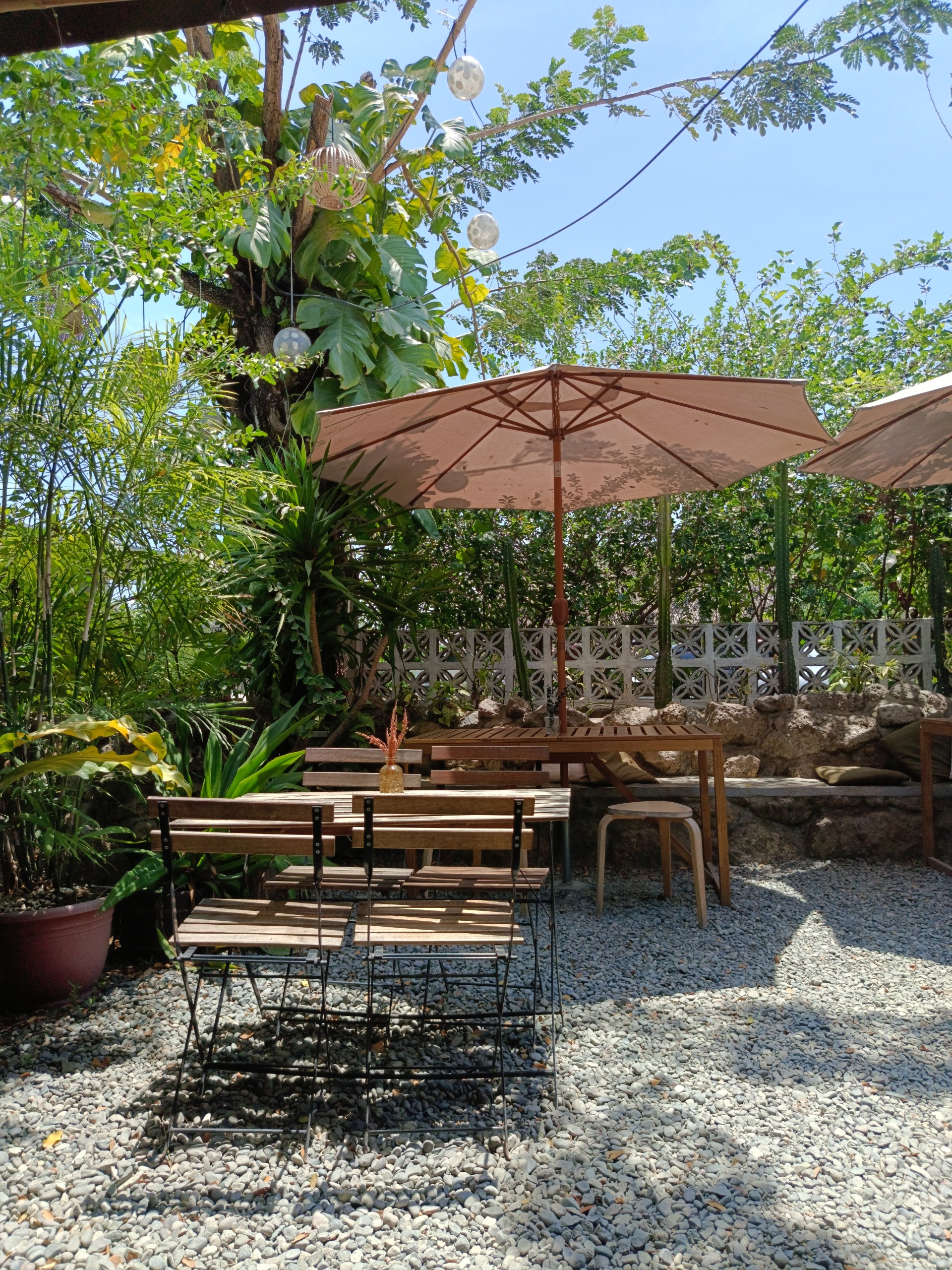
The High Res mode dedicated to capture 108MP photos doesn’t really pose that much of a difference. Sure, the photos may appear a tad but brighter but when looking closely, the highlights are overexposed.
Not just that, photos taken using the High Res mode generate massive files. I even took a single photo that is over 90MB in size.
The 3X zoom seems underperforming and inconsistent as well. The photos can look good and usable one time but frequently, it just appears oversharpened and heavily processed. The colors can be too saturated as well.
Low light photos taken using the realme 12 5G is also another yin and yang for me. When there is enough light, it can produce really impressive results but it can also struggle during the darker times when you feel like you really need it to perform as intended.
As for the selfies, I can say that I am quite happy with the phone’s performance. It may not be flagship level but it won’t let you down in your “me” moments.
The video is limited to 1080p at 30FPS for both the rear and front-facing cameras. I do believe that there’s some sort of EIS for the rear camera but the quality is nowhere near amazing.
So long, realme
One thing I really love about the midrange Android market is despite the competition price point, companies are really generous when it comes to battery and charging speeds. realme 12 5G is not an exception.
Packed with 5000mAh battery that supports 45W SUPERVOOC charging, quick battery drain and slow charging speed are a thing of the past. Being a heavy social media user, the realme 12 5G lasted me a whole day of use with a few more juice left before I reached out for its charger.
realme promises a 0-100% of charge in just 83 minutes. True to its claims, I was able to charge the phone from 20% to full in just 72 minutes. Impressive is an understatement.
You need to calm down, you’re being too loud
The realme 12 5G’s dual stereo speaker also has a feature called the Ultra Volume Mode that allows you to push up the volume level up to 200%. While it’s not necessarily bad, I find the audio quality to be a little bit harsh-edged and crunchy.
The bass is really lacking as well to the point that it kinda affects my music time with my current favorite bubble gum P-pop songs. The normal volume, albeit a little bit better, is not really an entirely different story. This just goes to show that just because it’s loud, doesn’t mean it’s a great speaker.
I think there’s been a glitch…or two?
Moving forward to speed talks, the realme 12 5G is powered by MediaTek Dimensity 6100+. Basic operations like browsing on social media is an easy feat for realme’s newest midrange device. Even multitasking seems smooth on this device, switching back and forth between apps hasn’t really been an issue on my end.
It does reload some apps, mostly games, when reopening them but I feel like that’s pretty normal for midrange android devices.
The gaming experience, however, is kind of underwhelming. When playing Roblox even on automatic graphics quality, I still experienced a considerably significant amount of frame drops. That became more frequent when I dialed up the graphics settings to maximum quality.
Surprisingly, I didn’t notice any frame drop when I played Asphalt 9 on default graphics settings and only a few occurred when I modified the settings to the highest graphics quality and 60FPS option.
As for the device’s temperature, the realme 12 5G may warm up during heavy use over an extended period, but it remains comfortable to hold. A brief rest allows the phone to cool down quickly.
You’ve got some tricks up your sleeves
Another thing that makes the realme 12 5G so interesting is the special features that come with it. Even though some of them can be viewed as plain gimmicks, some could be really useful. For example, the mini capsule 2.0 as realme likes to call it is an animation feature that is quite similar to Apple’s dynamic island, is nowhere near impressive and does not really improve the phone’s functions in any way.
On the other hand, the Snap Cards feature of the device which allows you to use your phone to store RFIDs by scanning the actual RFIDs could be a game changer for some people. Imagine you forgot your work RFID that records your attendance but hey, your phone is there to save the day! I believe things like these are what makes the realme 12 5G a fun device to have inside your pocket.
Other features worth mentioning include RAM expansion, dynamic button, and extra brightness.
Final Thoughts
To sum everything up, the realme 12 5G offers a wide spectrum of features a lot of people will love. With its unique aesthetic and color options, impressive sunlight display, and long-lasting battery life, it offers a holistic and fun experience for its users. . The device’s ability to deliver decent photos is also worth keeping in mind.
Its performance, although not perfect, still provides a satisfying user experience. To top all that off, it also has special features under its belt. With its competitive pricing, I will definitely recommend the realme 12 5G for people who love aesthetics and value functionality but do not want to break the bank.
Pricing and Availability
The realme 12 5G is the least expensive offering among the realme 12 series. Priced at Php 14,999, the handset comes with 8GB of RAM and 256GB of storage. You may purchase the device and get freebies on realme’s TikTok shop until April 30. The realme 12 5G will also be available on realme’s official Shopee and Lazada store on May 5 to 10.

We didn’t have the best impression of Stellar Blade after spending time with the demo. Unlike certain players who poured a full game’s length of hours playing, our reception was lukewarm due to various reasons. But after finally having some time to focus on it, we now have a better understanding of its charm–and that goes beyond character design.
The game’s director has been ever-present in various gaming and tech news websites sharing nuggets about the game and reacting to the many comments made about the proportions of its female characters. That’s a rabbit hole we’re not diving into. Instead, we’re piggy-backing on one of his responses: Just pick up a controller and play it.
Steep combat learning curve
Stellar Blade’s combat didn’t click with us right away. But that’s because we approached it more like a hack-and-slash and not for the precise combo-parry sequence that it demands. A fellow reviewer aptly described our experience: It was a lot more “Soulslike” than we anticipated.
It took a while to get over that hurdle. For one, this writer isn’t particularly fond of Soulslikes. Skill issue. That’s tough considering a big part of this game’s charm is its combat. We can’t say that it fully clicked with us, but it certainly has its moments.
In combat, you have to pay attention not only to your enemy but also to how the protagonist, Eve, acts in different combo animations. If you’re not careful, you might find yourself getting hit during a lull in your combo.
You don’t have to memorize every single combo, although if you could, that’s certainly an advantage. We can compare the practice to memorizing combos of characters in Tekken, although at a milder rate.
Parrying is tricky but that’s not the only way to counter your enemies. One of the first skills you unlock is one that lets you get behind your enemy after they unleash a fatal attack (cued in with blue indicators) and hit back with your own counter. The animation looks so good that you’ll feel like an absolute badass every time you do it. It’s one of the moves that never got old throughout the entire playthrough.
As you progress through the game you’ll unlock ranged weapons that will expand your combat capabilities further. Hard combat enthusiasts should have a field day.
For more casual players, there’s no shame in switching to Story Mode which is what we did for about 70% of the playthrough. It’s easier, sure. But it can still present challenges especially during certain encounters.
The boss battles are TOUGH
We’re going to chalk this up again to skill, and perhaps patience, issue. But Stellar Blade’s boss battles are incredibly tough. Not to the point that you’ll want to throw your DualSense controller though.
What can make it frustrating is that the patterns of the enemies, especially the earlier bosses and mini-bosses, are easy to track. But they’re not exactly easy to deal with.
Parrying becomes an even more critical skill in these encounters. It’s one of the reasons why we opted to slide down the difficulty. Otherwise, this writer will never finish the game.
Pulling from different games, worlds
We have seen many compare Stellar Blade to the Nier games. Other than the setting, another big contributing factor in that comparison is the soundtrack.
During roaming, exploring, and combat, the music will change from time to time. However, they stick to this theme that’s a little eerie. It’s hard for us to describe but it’s almost like a crescendo that never quite swells up. It matches the game’s world perfectly — it feels hollow and devoid of life but still has a sliver of hope.
Combat isn’t the only thing you’re doing here. While it’s mostly linear at first, Stellar Blade offers a healthy mix of exploration, platforming, and puzzle-solving.
The puzzles don’t get in the way of the pacing. They’re quite engaging and offer a decent level of challenge. Roaming and exploration will yield you loot to improve your gear and stats. Occasionally, a Naytiba (the game’s primary foils) will surprise you for a good jumpscare moment.
Stellar Blade doesn’t reinvent anything nor does it offer anything particularly new or groundbreaking. But everything it borrowed from other games is retrofitted to match the game’s vibe and overall aesthetic. The result is a polished experience of familiar gaming mechanics.
Eve
Another aspect that did not grab us as much during the demo is the main character, Eve. The first hour of the game doesn’t do much to endear the player to her.
That slowly changes as you play through the game. Through a mix of cut scenes and world-building collectibles, you get a better sense of what Eve is, her mission, and ultimately her purpose.
If you’re familiar with the animé Violet Evergarden, Eve and that show’s protagonist share a similar character arc. They initially seem one note and bland, but the layers are peeled back as you learn more about them and how they relate to the world and the people around them.
Is she hot? Hell yeah. But as cliché as it is, she’s certainly more than what meets the eye.
Should you play Stellar Blade?
Unlike the PlayStation 5 exclusive that immediately preceded it, Stellar Blade has plenty in common with past PS5 exclusives — visually captivating, cinematic experiences, with satisfying gameplay.
Its level of challenge is closer to Sekiro and Bloodborne but it’s also not quite as difficult. In the same category but certainly not in the same stratosphere.
It also has an alluring charm that goes beyond its aesthetics. As mentioned earlier, nothing about it is particularly new or groundbreaking. But it’s polished and cohesive. There’s something about the overall feel of the game that draws you in and makes you want to see it through.
Stellar Blade is a Day 1 purchase if you’re up for the challenge. And if you consider the game director’s goal of having a high quality AAA console game from South Korea which is dominated by PC and mobile gaming, we say they did just that. Now, it’s just up to us to pick-up the controller and play.
Reviews
Challengers review: A thrilling drama wrapped as a tennis anime
Catch it in Ayala Cinemas starting April 24th

Tennis is more than just hitting a ball really hard with a racquet. There are player tics, serving techniques, mind games, and, of course, drama off the court. Challengers, starring Zendaya, takes the entire game and turns it into a dramatic thriller worthy of Wimbledon.
In Challengers, Art Donaldson (Mike Faist) is an aging tennis superstar desperate for one more big win. His wife Tashi (Zendaya), a retired tennis star in her own right, does everything to coach Art back to his winning ways. Opposite them is Patrick Zweig, a former-friend-turned-rival, facing Art in the final match of a Challenger.
As premises go, Challengers seemingly presents a straightforward sports drama. It’s a simple one-versus-one, after all. However, the film’s 2-hour-plus runtime hides a more complex drama.
The second-strangest ménage à trois in film
The film starts in media res: the first set of the final match. It doesn’t tell you who Art, Patrick, or Tashi is. It’s just a friendly match. There are, however, questions abound. Why is Zendaya’s character looking intently at one of the players? Why is the other player concerned that she is looking at his rival and not him? Who are these people?
Before you can ponder each question, the film takes you through multiple time jumps. The earliest (and longest) of which — thirteen years ago — sets up the story. Art and Patrick are two best friends and tennis prodigies teaming up to decimate the competition at their school. Everything changes when the two friends catch a match of another young prodigy, Tashi Duncan.
Both friends engage in a friendly competition to see who can successfully flirt with her. The sequence ends in the second-strangest ménage à trois committed to film. (To see the strangest one, catch Alfonso Cuarón’s Y tu mamá también, a clear inspiration to Challengers.)
The time jumps don’t end there. The story quickly volleys back and forth between different times in the past and the present, including years, months, weeks, and even hours ago. Sometimes, the skips result in the cinematic equivalent of whiplash from watching a tennis ball rapidly travel from left to right. But if you just follow the ball, it ends with one of the most thrilling, edge-of-your-seat dramas this year.
Blink and you’ll miss it
Despite how creative the time skips already are, Challengers shines with its subtler elements: the tiny movements, the tics that seasoned sports watchers can catch. Much like how a play-by-play commentator directs a viewer’s attention to what makes a player tick, the film subtly shows you elements of an even deeper story that it may or may not expound on.
Early on, Challengers shows a blink-and-you’ll-miss-it scene featuring Tashi’s knees. If you weren’t paying attention, you might have missed a scar from a surgical incision, hinting at why Tashi retired from the sport.
In that particular example, the film does dwell on it a bit in a past flashback. However, there are plot points that the film just drops on audiences with nary an explanation. For example, you might see telltale injection marks up Patrick’s wrist or a short-but-telling rehab session for Art. The film drops these nuggets only for the viewer to ponder. They’re short, but they paint a compelling picture to complement the action on the court.
It’s a tennis anime
In essence, Challengers is just about a tennis match between two emboldened competitors. However, like an anime battle that takes ten episodes to resolve, the film understands that the sport is not just about results: it’s about all the tiny movements, strategies, and dramas. If Wimbledon was this thrilling all the time, I should probably tune in a lot more.
Challengers shows exclusively in Ayala Cinemas starting April 24th.
-

 Features2 weeks ago
Features2 weeks agoFortify your home office or business setup with these devices
-

 Reviews2 weeks ago
Reviews2 weeks agorealme 12+ 5G review: One month later
-

 Gaming2 weeks ago
Gaming2 weeks agoNew PUMA collection lets you wear PlayStation’s iconic symbols
-

 Accessories1 week ago
Accessories1 week agoMarshall Major V: Reasons Why I Love It
-

 Gaming2 weeks ago
Gaming2 weeks agoMore PlayStation 5 Pro specs have been leaked
-
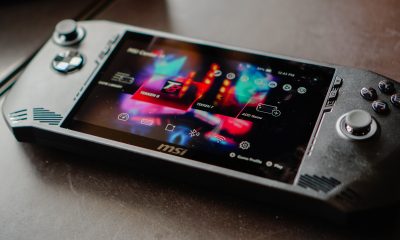
 Features1 week ago
Features1 week agoWhy choose the MSI Claw?
-

 Gaming2 weeks ago
Gaming2 weeks agoUbisoft is taking away copies of The Crew from your library
-

 Gaming2 weeks ago
Gaming2 weeks agoOne Piece Odyssey coming to Nintendo Switch



